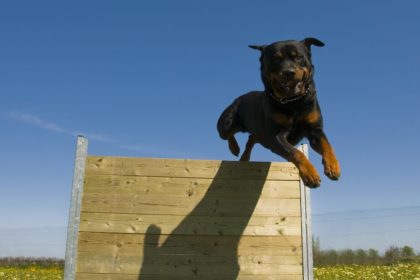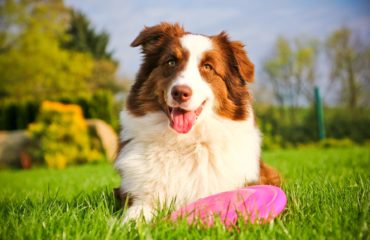Dog Agility Training At Home: Equipment, Tricks & Advice

Dog agility is a recognised dog sport all over the world, with many organisations hosting competitions for owners and dogs of all breeds to showcase their skills and win awards. Despite this, dog agility doesn’t have to be a serious affair that requires you to dedicate hours into training and practise. Dog agility training can simply be a fun activity for you and your pet to enjoy together, with the added benefit that it keeps your dog’s fitness levels up and allows them to burn off plenty of steam.
No matter how seriously you want to take dog agility, you can get stuck into the sport by constructing DIY obstacles for your garden and training yourself and dog over time to become masters of communication. Agility dog training isn’t just about teaching your dog new behaviours but involves learning new skills and developing from a dog owner to a dog handler. It takes time and dedication but the benefits for your dog’s fitness, confidence, anxiety levels and overall wellbeing make it highly rewarding.
The great thing about starting to familiarise your dog with agility obstacles at home is you can take it completely at your own pace and keep it fun, without your dog having to be on its best behaviour. It’s important to keep in mind that some dogs are more naturally gifted at agility than others and not all dogs will enjoy or excel in competitions. Dog agility training at home allows dogs of all breeds, sizes, ages and abilities to have fun without the pressure of an audience.
Dogs love to be active and learn from their masters, both things that agility allows them to do, so what are you waiting for? Grab some old household items and spend some quality time outdoors with your dog. Benchmark Kennels are here to share some of the major benefits of dog agility training with some easy DIY dog training equipment to try.
Is agility training good for dogs?
While dog agility involves dogs following many behavioural commands and might seem like hard work, a dog will never view it as such. Agility gives dogs the opportunity to do what they’re born to do, keeping both their body and mind active and stimulated.
-
Reduces anxiety
An active and busy dog is a happy dog, which is why behavioural issues and separation anxiety is seen more in dogs that spend a lot of time lazing around or on their own. By starting an activity that involves both you and your dog being up on your feet and learning new commands, you can tire your pet out mentally and physically.
If you find your dog is still energetic after a long walk this is usually because their mind has not been active – agility ticks all boxes, leading to a healthy and happy dog. Once you’ve started regular dog behaviour training using agility obstacles, you are sure to notice far less negative behaviours in your dog when you do have to leave them in outdoor dog kennels or in your home for periods of time.
-
Trust and communication
As well as improving the overall behaviour of your dog, dog agility training also hugely strengthens the bond between an owner and their dog. Your dog will learn to trust you completely as both your communication skills develop. Agility training essentially involves the two of you learning a mutual language to communicate with each other, consisting of body language and verbal commands. As your dog learns to understand your every move, your relationship can only get stronger, benefitting you in a range of other situations where you need your animal to behave and stay by your side.

What age should you start agility training?
It’s important not to start using agility obstacles or courses until your vet has approved this. A young dog below one or two years can severely damage their bones if they try to jump or move in certain ways while they’re still growing.
Although you need to wait till your dog is fully grown to start agility, being proactive with any dog behaviour training from an early age is still important if you want to start your dog’s behaviour on solid foundations. Teaching your dog basic key commands like ‘sit’, ‘lie down’, ‘stay’ and more will always be valuable in everyday life but especially when it comes to trying your hand at agility, whether you plan to do it for some fun or to compete. A dog that is already familiar with learning commands and can listen to your communication will find it far easier to pick up agility tricks than a dog who has been allowed to run riot all through its early life.
How to start dogs in agility training:
Attention
First off, you need to make sure your dog can focus its whole attention on you. Try to set up any dog training equipment in an area of your garden with minimal distractions at first, to give you and your dog the best shot at learning new tricks. Once your dog has shown that is can listen carefully and follow your lead, you can start to practise in slightly busier areas to build up your dogs ability to block out potential distractions.
Body and spatial awareness
Although our dogs are eager to learn and are intelligent by nature, when it comes to some practical skills like spatial and body awareness, they can fall short. Luckily, you can help your dog to understand its own size and be aware of its limbs and where they’re being placed. Rather than investing in legitimate dog agility training equipment, use narrow household items to practise your dog jumping up and keeping its balance.
The ‘back up’ trick, in particular, requires dogs to think of each individual leg as they walk backwards, benefitting both spatial awareness and coordination skills – and an ideal command to teach to help with agility!
Flexibility
Dog agility training is great for improving your dog’s flexibility as well as their fitness. Certain tricks, like weaving between poles and bowing, help to stretch a dog’s muscles in ways they wouldn’t normally get to. To start off with, teach your dog to weave between your legs. Once your dog understands how to move their body in certain ways, you can move onto helping your dog practise weaving around poles or other obstacles. Improved flexibility has major benefits for your dog’s mobility and joints, something which will be hugely valuable for your animal in later life.
Handling
While the main focus is on your dog learning certain moves and tricks, the methods used by you as a handler are key to grasping basic agility training. You need to use positive techniques and have a trusting relationship already established with your pet if you are to succeed.
Transforming from a dog owner into a handler involves using firm language and positive reinforcements such as treats or attention to reward your dog when necessary. It’s important to be patient and tackle each trick and agility obstacle one by one and gradually, to avoid confusing your dog.
What obstacles are in a dog agility course?
Agility is an easy and highly accessible sport to get into. Don’t go out and invest in a range of agility dog training equipment when you can create DIY options that are just as effective for beginners.
- Contact obstacles
There are a few contact obstacles such as the ‘plank walk’ which involve your dog jumping up or walking along objects. While there are specific dog planks on the market, save yourself some money and start out using park benches or other long items around your garden to help your dog practise balancing and become familiar with moving along an object.
- Tire jumping
Use safe objects such as large spare tires or hula hoops to practise your dogs jumping. Keep your DIY agility obstacles at a reasonable height of around two inches to avoid your dog straining its back and use a training lead to direct your dog to jump through, not around, the object. Using plenty of treats and consistent ‘jump’ commands should have your dog ‘jumping through hoops’ for you in no time.
- Tunnels
Got any old kids play tunnels in the back of a shed somewhere? These are ideal replacements for agility equipment and perfect for teaching your dog to run through tunnels. You can even use hollowed out cardboard boxes lined up. Dogs are naturally wary of unknown and dark spaces, so you will likely need to offer a treat or inventive at the other end while your dog gets used to this obstacle.
- Weave poles
Weaving is arguably the hardest agility obstacle for dogs to learn. It involves your dog bending in ways it likely hasn’t had to do before, so you should be prepared for the long process and plenty of patient practise required. At first, use sticks, brooms, plastic cones or any long object that you can stick in the ground on diagonals to each other, allowing you to build up the amount your dog has to bend its body. With enough practise, your dog will understand how to do the movements and will be able to weave in and out at great speed!
Need a wooden dog kennel to help with your agility training?
Investing a quality wooden or WPC eco-thermal dog kennel is a great way to keep your dog safe and secure outdoors when you’re not training. With dog agility training being mentally and physically stimulating for your pet, you can use an outdoor kennel as space for them to relax and unwind out of harm’s way, without having to leave them unattended in your home.
Benchmark Kennel’s are a leading dog kennel manufacturer, offering custom kennels with quick installation to homes all across the UK. Get in touch with their team of dog experts today or customise a kennel online and have it delivered in as little as seven days!
15 Comments to “ Dog Agility Training At Home: Equipment, Tricks & Advice”
You must be logged in to post a comment.





… [Trackback]
[…] Read More on to that Topic: benchmarkkennels.co.uk/dog-agility-training-at-home […]
… [Trackback]
[…] Information to that Topic: benchmarkkennels.co.uk/dog-agility-training-at-home […]
… [Trackback]
[…] Find More Info here to that Topic: benchmarkkennels.co.uk/dog-agility-training-at-home […]
… [Trackback]
[…] Find More Info here on that Topic: benchmarkkennels.co.uk/dog-agility-training-at-home […]
… [Trackback]
[…] Info to that Topic: benchmarkkennels.co.uk/dog-agility-training-at-home […]
… [Trackback]
[…] Find More Information here on that Topic: benchmarkkennels.co.uk/dog-agility-training-at-home […]
… [Trackback]
[…] Read More here on that Topic: benchmarkkennels.co.uk/dog-agility-training-at-home […]
… [Trackback]
[…] Find More here on that Topic: benchmarkkennels.co.uk/dog-agility-training-at-home […]
… [Trackback]
[…] Read More here to that Topic: benchmarkkennels.co.uk/dog-agility-training-at-home […]
… [Trackback]
[…] Find More on to that Topic: benchmarkkennels.co.uk/dog-agility-training-at-home […]
… [Trackback]
[…] Info on that Topic: benchmarkkennels.co.uk/dog-agility-training-at-home […]
… [Trackback]
[…] Find More Information here to that Topic: benchmarkkennels.co.uk/dog-agility-training-at-home […]
… [Trackback]
[…] Here you will find 1902 more Info on that Topic: benchmarkkennels.co.uk/dog-agility-training-at-home […]
… [Trackback]
[…] Read More here to that Topic: benchmarkkennels.co.uk/dog-agility-training-at-home […]
… [Trackback]
[…] There you will find 91851 more Info on that Topic: benchmarkkennels.co.uk/dog-agility-training-at-home […]